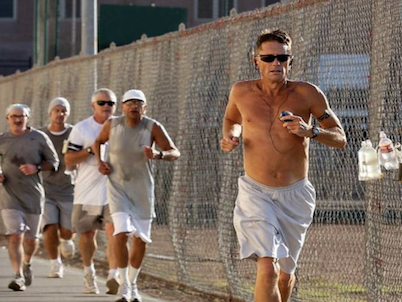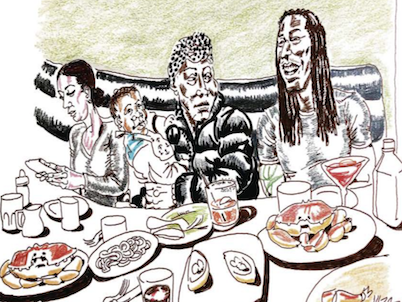Running Free at San Quentin
“I’m not a betting man, but if I was, I’d put my money on Fidelio,” says Markelle “the Gazelle” Taylor, winner of the 12th Annual San Quentin Marathon—and the three before that. He isn’t running this year. The 26.2-mile race, held inside the 30-foot walls of what’s got to be the prettiest prison in the world, is for inmates only.
Prettiest, at least, from the outside, where the sparkling San Francisco Bay stretches to the sky and Mt Tamalpais rises above the barbed wire.
The Gazelle always appreciated that view of Tam while running around and around and around the prison yard. He completed his last San Quentin Marathon—105 laps around a quarter-mile track— in a record 3:10:42. A few months later, paroled after 18 years, he ran to the top of the mountain he’d been looking at for so long. (And then he ran the Boston Marathon, in 3:03:52, his personal best.)
No one is going to beat Markelle’s time this year, predicts Frank Ruona, 74, crazy-accomplished ultra-runner, Vietnam vet, longtime coach of Marin’s Tamalpa Running Club—and head coach of San Quentin’s 1,000 Mile Club, since its inception in 2005.
But on a sunny, 46-degree Friday morning in late November, two guys set out to try: Fidelio Marin and Mark Jarosik. Lifers both, like most of the 4,215 inmates at the maximum-security penitentiary, California’s oldest.
I don’t want to know what these guys did to get in here.
Coach Frank sends me the roster of runners in advance, their names right there, ready for me to type into Google. Instead, I concentrate on another email I receive: a Word doc detailing what not to wear. The list is long. No jumpsuits. (Noted.) No sweats. No gray or white or denim or anything resembling denim—or anything that might make me resemble an inmate.
So that the guards with guns watching from the towers above can easily distinguish you, I’m told, in the event of any trouble.
It doesn’t explicitly say no body-hugging Oiselle pants, which is what I usually wear running, but as Kevin Rumon, another longtime volunteer, put it over the phone: “These guys don’t get a lot of female communication, so…” Also, he reminds me, I won’t be running.
*
The sun rises as I cross the Golden Gate Bridge. I breeze through the rainbow tunnel and pass all the Highway 101 exits I typically take. Sausalito, Stinson Beach, Muir Woods. Just past the posh Marin Country Mart, home to $400 bikinis and $32 burgers, I follow signs to its antithesis, another iconic Marin County destination. The one I’ve driven by for years — yet have never been to.
It’s about two minutes till race time and the first runner I meet is Fidelio. At 49, he’s wrinkle-free, with warm eyes and a wide smile, dressed in droopy gray shorts, white socks, and donated gray Adidas sneakers. He has a white napkin wrapped around his forehead, like a bandana. I ask what he had for breakfast. “Snickers,” he says.
There’s a digital clock on the ground and a homemade “1000 Mile Club” banner hanging over “San Quentin’s Field of Dreams” scoreboard, but otherwise the runners gather without fanfare.
No one else on the yard seems to care, nor much notice, that there’s a marathon today. Not the men doing push-ups or the men punching bags or the men playing dominos or the men, so many men, ambling the same track in long denim jackets marked CDCR Prisoner. The geese puttering around the patchy grass could give two poops, too.
‘But these runners do. They’ve been training all year for this, with Coach Frank and Kevin and a handful of other elite runners—who are here this morning, in black puffy coats, with stopwatches and clipboards and pouches of berry-flavored Gu. All lifers in their own way, they joke. They care, too.
“It’s one of those corny-sounding things,” says ultrarunner Diana Fitzpatrick, 61. “About getting more out of it than I put in, but it’s true.” She hasn’t missed a San Quentin marathon. The first had only one finisher, she recalls. Ronnie Goodman, since paroled. A lot of 1,000 Mile Club runners have been paroled.
Running today are 30 of the 60 or so in the group. Not all are looking to finish and 17 are injured and not running at all. (Hips. Hernias. An ingrown toenail.) Still, they’re here help, to hand out water, to cheer on their teammates.
Like Brett Ownbey. “Positive affirmation isn’t something you typically get a lot of in prison,” he says. The 1,000 Mile Club has given him that, and more.
Incarcerated for 17 years, he’d never run before arriving at San Quentin last September, weighing 252 pounds. He has since completed his first marathon, in four-and-a-half hours, and lost 62 pounds. “Running has taught me to set goals, and attain them,” says Brett, 45. “When I’m on the track, I’m in the present. I’m not just a prisoner. I’m human.”
Manning the starting line chalked in gravel, he finally feels a part of something, he explains. “Individually, you know, we’re all going at our own pace, at our own ability—but together, we make up the club.”
“3-2-1,” Frank counts down, and they’re off. A ragtag group, ages 22 to 72; whites, blacks, Latinos, Asians. The rest of the yard might be segregated, but not the 1000 Mile Club. “There’s no racial bullshit” as one runner puts it.
“This track is horrible,” says Ralph Ligons, 68, cofounder from a plastic chair on the sideline. He was an All-American sprinter at Cal State Sacramento who competed in the 1972 Olympic trials, before being sentenced 25 years to life, before he had a cane and his scraggly goatee turned white. He retired from running ten years ago. “But I never stopped walking,” he says. “You’ve got to keep going.”
Part-pavement, part-dirt, the “route” has six 90-degree turns and all sorts of distractions. It starts in right field, near the flaming sweat lodge, then cuts between the busy basketball court and the always-taken tennis court, weaving past a pull-up bar and an artist displaying his work.
A few things, though, make this race different from any other in Marin County: the sporadic prison alarms forcing everyone on the yard to sit down where ever they are, until the issue, whatever it is (medical, rioting, murder), is resolved.
Perhaps the toughest thing: “Every lap, you’re passing the finish line,” says Nicola Bucci, 47. “You’re thinking: ‘When’s it going to end?’” Not unlike prison itself, he adds.
Recovering from surgery, Bucci is sitting this one out. He completed his first marathon last year, coming in dead last. Didn’t matter. “It felt like coming in first,” he says. “It gave me the will to want to continue. It helped me realize that whatever I face, I can overcome.”
“Only 102 laps to go!” cries Dan McCoy, giving a thumbs up as he goes by. There are no live bands or little kids holding signs or water stations. Most guys BYO in old plastic Pepsi bottles, to hang on the chain-link fence. Some are topped with squirt caps Kevin bought for them on eBay, so they can drink and run.
Eventually, the smiles and waves turn to groans, guys gripping hamstrings, some shuffling to a walk.
John Levin, 55, a two-time finisher, cuts out after 18 miles. “Hey, sister!” he jokes, having heard we share the same last name. His brother loaded up his MP3 player with running-themed songs, he tells me. “Born to Run” by Bruce Springsteen. “Marathon” by Rush.
John came to San Quentin with a degree in computer science, but had never run before. “It means everything,” he says, wiping away tears. “That coach, and all these free people, show up, and can look past your poor decisions and treat you like a real person, like you’re not the worst thing you’ve ever done.”
For most of the race, Fidelio is indeed in the lead, a full lap ahead Mark. Until mile 21—lap 87—when he rolls his ankle.
Mark pulls ahead. He’s got less than a mile to go. “Down in the yard,” booms a voice over the loud speaker, cramping the runners’ style. Seventeen minutes later, they’re allowed up.
The last lap is a short one, the .2. Shirtless and chest puffed, 107.7 “The BONE” blaring in his ears, Mark barrels toward the finish line.
Brett and Bucci hold up a piece of red plastic tape that reads “Danger” — and he busts through, six minutes short of Markelle’s record.
Feeling like a lone SportsCenter reporter after the SuperBowl, I scurry over, holding up my mini-recorder. “There’s a new king in town,” says Mark, with a wry smile. Then softens for a moment. “Running takes you out of this place.”
Fidelio rolls in two minutes later; second place but still beaming.
Steve Reitz finishes at 3:41. His mom is going to be proud, he says. Vicente Gomez follows in white stocking feet. He kicked off his crappy sneakers four miles ago. Blisters.
Watching them go by is Warren Corley. He’s inspired. “I had no idea there was a race going on. I was just sitting on the wall and said, ‘Hey, I know half those guys! I’m gonna get them some water.”
This is his second stint at San Quentin. His first was in the ‘80s, he tells me. “It was another place back then.” Riots. Murders. Tension all the time. “None of this was here,” he says, surveying the yard. No tennis. No garden. No 1,000 Mile Club. No marathon.
“I could imagine doing this,” says Warren still holding a cup no one has grabbed. “Yeah, I’m going to run next year.” He pauses. “I’ll be here.””
The marathon won’t be over for another couple of hours.
Fourteen more guys will finish, including fresh-faced first-timer Michael Johnson, who fixed to have a friend waiting at the end with Peanut Butter Panic ice cream. (“I lent him a calculator earlier,” he explains.)
And, for the fourth time, Tommy Wickerd, his tattooed arms bulging, his bad knees holding, his bald head inscribed: “Ma & Pa I Tried.” He never ran long distance before prison. “The cops always made sure I didn’t get very far,” he jokes. Then turns serious. “Running has changed my life. When I’m running, I’m not in prison. I’m thinking about my father, my grandkids, my next breath, my next step.”
Brett and Bucci string up the red tape for every runner crossing the finish line, as if instead of Danger, it reads: fresh start.
I’m ushered out before the end of the race. I leave these men and their mistakes and regrets and hopes and dreams. And Mike Keeyes, still trucking tortoise-style at 72, before he finishes his fifth San Quentin Marathon in five-plus hours. He’s been incarcerated for 45 years. My entire lifetime.
These guys run, I realize, for the same reason I do: to feel alive, and free.
The bars clank close behind me and I drive out along the bay toward Tennesee Valley. I swap pants and hit the trails until the sun starts to set.
Later, at home, I can’t help it: I Google. Yet like Coach Frank and Kevin and San Quentin’s geese, I don’t care. I want to go back.



